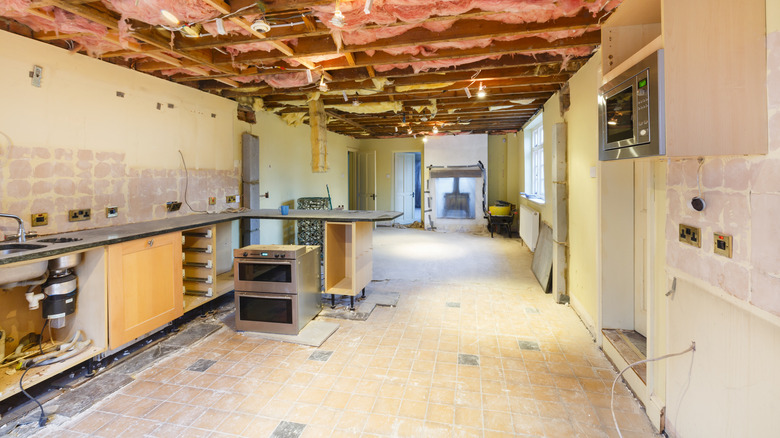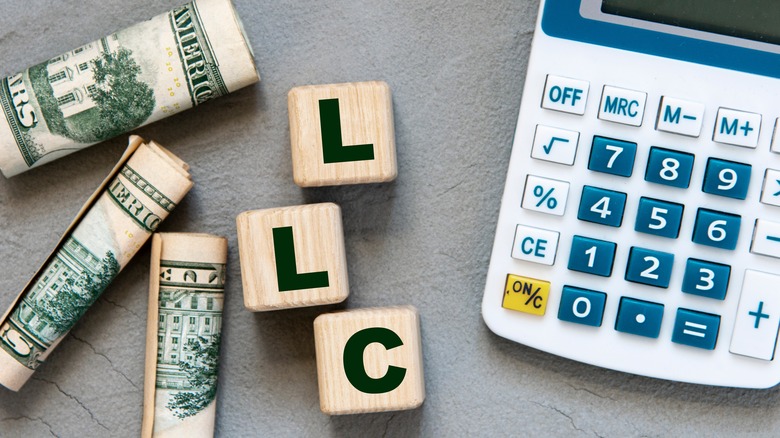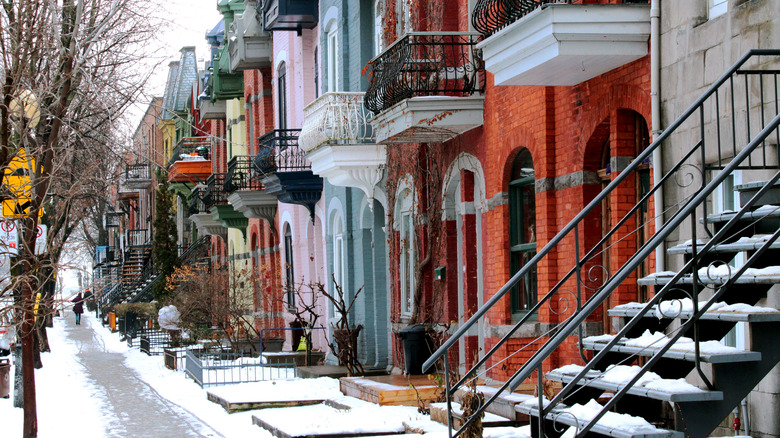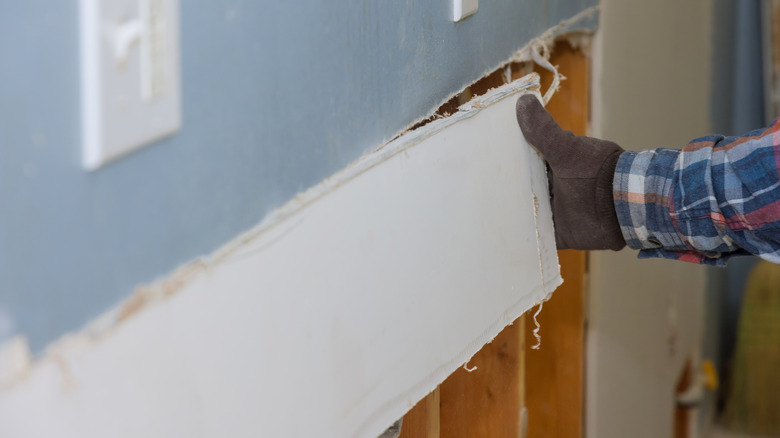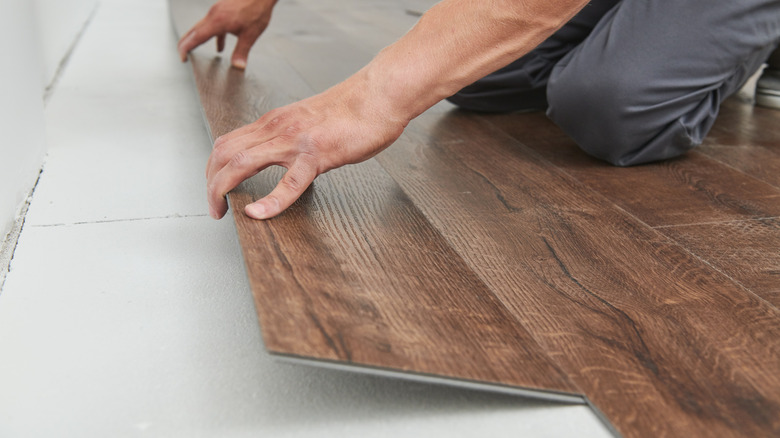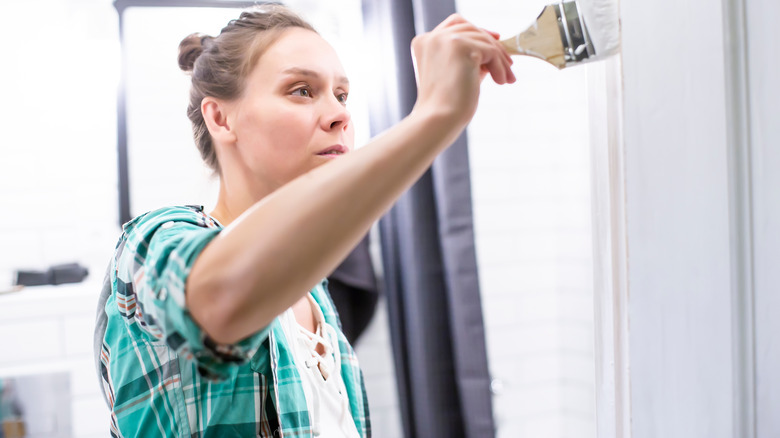How To Start Flipping Houses
Flipping houses is a great way to invest your money. If you aren't sure what it is, flipping a home is when someone buys a house that needs work, hopefully, at a low price, then they fix it up and resell it to gain a profit. There is some risk involved, but thankfully real estate never goes out of style. There are many benefits to house flipping, including a potential business that allows you to work from home and create your own hours. According to Flipper Force, there is little startup cost and you have an opportunity to improve local communities.
If you enjoy remodeling and have some knowledge about real estate, house flipping is a great career option or even a side hustle. Keep in mind that the process isn't without stress. House flipping requires a lot of work and even more patience, as surprises can pop up along the way when remodeling any home. Also, you're sometimes at the mercy of the real estate market's temperature. Here is everything you need to know about how to start flipping houses as a new house flipper.
Should you flip or micro-flip?
Micro-flipping is a faster process than the full renovation flip and offers a quick turnaround. If you don't have a team, it might be an ideal way to get into flipping. According to Rocket Mortgage, micro-flipping is buying houses under market value and reselling them quickly for a higher price. There is no renovating involved.
One benefit of a micro-flip is that you can do it all from the comfort of your home. Most micro-flipping happens online. That's good and bad news for those interested in doing it as a business. Sites like Zillow and Redfin are major players in the micro-flipping biz, which means stiff competition for a newbie in real estate investing (via FortuneBuilders). Still, it's not impossible, and if you enjoy the idea of closely watching real estate market trends, micro-flipping might work. However, if the renovation process gets you excited and you aren't in a hurry, you're likely to make more money with a complete renovation or remodel flip. Buyers love clean, newly renovated houses.
You need a business plan
Flipping houses is a business. Just like any business, going into it without a plan is unwise. The U.S. Small Business Administration writes that a business plan isn't as hard as it sounds. It's a tool to help you outline and project a few years ahead for your business. Business plans help keep you on track, allow you to reach your milestones, and even assist you as you seek funding. A business plan helps possible investors and lenders see you're serious and you know what you're doing.
You have ideas and goals in mind. A written plan gets those thoughts in order and helps you and your team see where you're headed and the end goal. It can also show what's lacking and missing areas. In your business plan for flipping houses, state your summary first, which explains what it is you're doing (via Rehab Financial Group). Next, the mission statement should explain why you're doing it. Include a CMA (Comparative Market Analysis), the project timeframe, and your financial strategies and projections.
Build your team
Unless you can do electric, painting, drywall, plumbing, and take care of all the legalities, you need a team. Even if you can do it all, you'll flip the house quicker with support. A team usually consists of a real estate agent, an attorney, a CPA, an insurance agent, and a general contractor who chooses everyone to assist with the renovation. You can also hire individuals as needed. For example, rather than having a contractor, you can hire an electrician, a plumber, and a drywaller. That part depends on how much you do on your own and how comfortable you are as your own contractor. TRUiC recommends going the general contractor route and mentions that a good general contractor is essential to a house flip. They can mean the difference between a profit and a loss. Think of it this way. Are you working another job? Do you have a family? Without a general contractor on your team, it's all on you, and you will be married to the flip project.
In the same way, everyone on your team is essential. It can be tempting to save some money by doing the home searching without a realtor, hiring each individual to do the renovations, and figuring out your finances and tax issues on your own rather than hiring a CPA. However, this method will probably take twice as long. Although it might seem like you're saving money, you could spend more if you make mistakes and miss deadlines.
Consider becoming an LLC
LLC stands for limited liability company. As a business, an LLC protects your personal assets should someone decide to file a claim against you. An LLC isn't necessary if you're doing a one-time flip as more of a hobby. However, it's essential to protect yourself if flipping is becoming a business for you.
An LLC isn't required to run a business, but there are many benefits to having one. LegalZoom explains that an LLC protects you from being personally liable should your business be sued. When unprotected, anything you own is at risk. Banks are less likely to give a loan to a business that isn't an LLC. They like to see that your business is protected. An LLC protects the name of your business. Once you're an LLC, no one else can use that business name.
There are several steps to forming an LLC (via TRUiC). First, select the state of operation, then come up with a name for your business. After that, you need to hire a registered agent service, such as LegalZoom. These services will walk you through each step and handle the legalities, such as filing with the state, creating an operating agreement, and getting your EIN (Employer Identification Number) to help file taxes. Simply put, an LLC gives small business owners peace of mind.
Choose your neighborhood
You've probably already been thinking about this step of the process. Where do you want to flip houses? Not every area will bring the same ROI (Return on Investment). Rock Realty mentions two places to look when searching for homes to flip: rebounding neighborhoods and new housing clusters. Rebounding neighborhoods are areas that are more established and have older homes. When many homes begin renovating and buyers notice, it's a rebounding area. As a flipper, you can swoop in, renovate one yourself, and then sell it. New housing clusters show potential when looking for a house to flip because the older ones around the new homes could be renovated and sold.
You may want to stay in your own city or town where you're familiar with the neighborhoods, but you could also venture out to other areas if the potential is better. Keep an eye on up-and-coming places and towns that are suddenly booming or trying to attract more people. You don't want to invest in a flip in an undesirable neighborhood. Do some networking with real estate agents, or better yet, add one to your team. They can alert you about houses on the market that offer great value for a flip. You can also become a "farmer." Farming is the term used in the real estate industry to describe how some real estate agents farm an area with postcards and mailings so that future sellers remember their names. As a real estate investor, you can do the same thing.
Obtain financing and buy a house
You'll need financing for your first flip unless you're paying cash. There are more costs to flipping than just buying the house. There are the renovation costs, homeowner's insurance, and possibly the cost of utilities. It's challenging to work with no electricity or running water. Explore a few places before deciding on a lender and ensure you get the best deal.
There are four types of lenders for houses, including private, hard money, fintech services, and crowdfunding sites, per Rocket Mortgage. Private lenders include banks, financial companies, and credit unions. Hard money lenders require real property as collateral, fintech services are app-based lenders, and crowdfunding sites are cloud-based services where a home buyer can seek funds from investors. Though private lenders are what most people are familiar with, it may not be your best option for a short-term loan to flip a house. That's why shopping around is so important. Understand your finances before considering a loan to flip a house. Get out of as much debt as possible before taking on any more debt.
Fix major issues first
Now it's time to flip. Painting and staging are fun, but you'll first need to fix structural, electrical, or plumbing issues. Axiom Power points out that when flipping a house, other than changing a light fixture or doing other minor electrical repairs, you need a permit and an electrician to complete the electrical work. Some signs the home may have significant electrical issues are buzzing outlets and switches, flickering lights, burning smells, charred outlets, or breakers and fuses that go out often. Drains that keep clogging or multiple drain clogs, low water pressure, discolored water, or an unpleasant odor in the house are all signs of plumbing problems (via HELP Plumbing). Call the licensed plumber on your team or hire one to fix any plumbing issues.
Structural damages compromise the interior and exterior of a home. When the damage is bad enough, the structure could possibly fail to support the house (via Forst Consulting Group). Nothing else matters without a sound structure. A home can also have drywall issues, especially if there has been water damage. Walls won't look smooth if sheetrock isn't mudded and sanded properly. If there is a lot of drywall to replace, consider it one of the top priorities. Get the house safe and sound, and then start the next steps.
Choose your flooring
Once the structure is sound, it's time to replace the flooring if necessary. You need flooring that is current, easy to maintain, and not too difficult to install. If you're wondering which flooring that might be, Parterre Flooring Systems explains that out of all the types of flooring today, vinyl is a consistent winner in the popularity contest. On top of that, it's easy to maintain. Vinyl flooring is highly durable, thanks to its surface that resists stains and scratches (via America's Floor Source). It's easy and cost-effective to install, and you can plan for it to last up to 20 years.
However, you don't have to choose vinyl. You may live in an area where ceramic tile or carpet is more suitable. A loft in the city will have a different vibe than a suburban home. Each requires its own style of flooring. Regardless of location, vinyl floors are an excellent option if you aren't sure what to pick. Remember to ensure the floors are installed correctly, kept clean, and ready to handle plenty of foot traffic.
Keep in mind when flipping a house that colors should remain neutral. You might like the thought of an unusually colored floor, like purple carpet in the bedrooms. However, many potential buyers will not. Neutral-colored flooring helps potential buyers to envision their own lives in the home (via Frederick Real Estate Online).
Paint and add final touches
Finally, the repairs are complete, and your team can make the home look beautiful. Choose neutral paint shades when flipping houses. Asset Based Lending recommends bright whites or grays as a neutral, modern color choice. You can also paint brick walls, doors, and cabinets. You may need to clean the walls before painting, depending on the home's condition or how much dust has been flying during repairs. When choosing a paint sheen, semi-gloss is for high-traffic areas and places with moisture, such as the kitchen or bathroom (via Mission Painting). Satin paints are a happy medium with a velvety finish. They work well for family rooms and bedrooms. Save the high glosses for cabinets, doors, trim, and molding.
Final touches on your newly flipped home can include towel bars, faucets, and light fixtures. Choose metals and colors that are current. Brass, brushed metals, and matte black are sought-after fittings (via G.J. Gardner. Homes).
Painting and final touches are a part of the process that many flippers might feel comfortable completing. Depending on your skill level and budget, you can choose whether you have a painter on your team or if that's something you can knock out on your own. You won't need much more than a drill and some screws for most accessories. Walk through the house and imagine yourself as a buyer. Ask yourself if you feel you could live there and what you would want in a new home. That should help you visualize the colors and little touches that are needed.
Market the home
You did it! You flipped the house, and it's time to sell. Will you list it as a "for sale by owner" or have a real estate agent on your team who can list it? Don't be tempted to forego a real estate agent to save on commission costs. Real estate agents know the housing market and all the ins and outs of marketing your home. Selling a home in a reasonable amount of time isn't as easy as it looks.
Agents are experts in the field, understand all the lingo, and can help secure excellent deals with their negotiation skills, per Realtor.com. They often have plenty of connections from constant networking. Also, agents adhere to a strict code of ethics, and in many states, they study and take a test about ethics every two years. A real estate agent is on your side and prepared to do battle for you to find a buyer. Don't take on the stress of going at that alone. It could mean the difference between a one-week sale or one year.
Consider getting listed as a "coming soon" home to generate excitement (via Houseopedia). Knowing the home has been flipped often creates interest, even if it's just nosey neighbors. The more traffic, the better. Open houses are also effective ways to show the house and let people know what you've done to it.
Invest your earnings
After selling your first flip, you have a decision to make. Are you going to invest the profits into another flip? New Silver writes that the average range for return on investment for flippers is 10 to 20 percent. So, for example, assuming an ROI of 15 percent on a $100,000 house flip, there would be a gain of $15,000. Many things make a difference in those numbers, including the house location, the selling price, and how much you owe the bank as the house flipper.
If there is a large enough profit, and the goal is to continue flipping homes as a business, then investing the money into another home is wise after you pay off the first one. It begs the question, how many homes can one flip in a year? Of course, there are lots of moving parts that make every situation different. Still, there are no legal limits to how many you can flip. However, if all goes well, a flipper can realistically renovate around two to seven homes a year (via Flipping Prosperity). Factors like having a team, ample budget, and a decent housing inventory can affect these numbers.
In conclusion, flipping houses isn't easy. It's a risk but sometimes worth it. It may be an excellent investment choice if you've done your homework, can get the financing, and are willing to share profits with a team.

